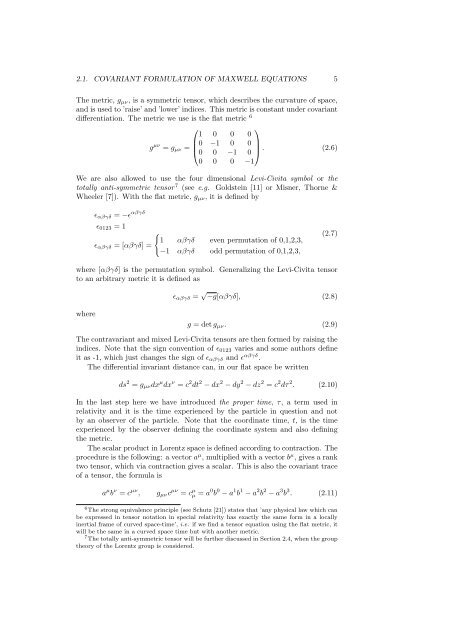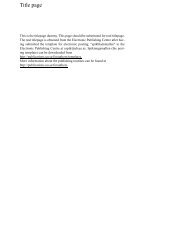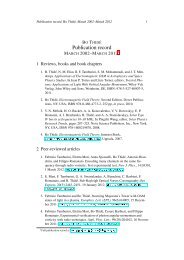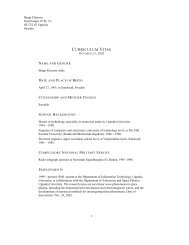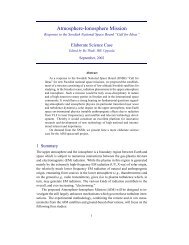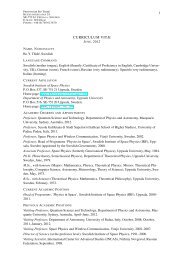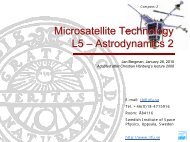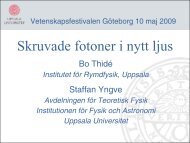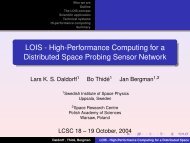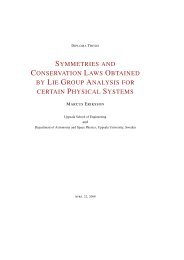Towards a covariant formulation of electromagnetic wave polarization
Towards a covariant formulation of electromagnetic wave polarization
Towards a covariant formulation of electromagnetic wave polarization
Create successful ePaper yourself
Turn your PDF publications into a flip-book with our unique Google optimized e-Paper software.
2.1. COVARIANT FORMULATION OF MAXWELL EQUATIONS 5<br />
The metric, g µν , is a symmetric tensor, which describes the curvature <strong>of</strong> space,<br />
and is used to ’raise’ and ’lower’ indices. This metric is constant under <strong>covariant</strong><br />
differentiation. The metric we use is the flat metric 6<br />
⎛<br />
⎞<br />
1 0 0 0<br />
g µν = g µν = ⎜0 −1 0 0<br />
⎟<br />
⎝0 0 −1 0 ⎠ . (2.6)<br />
0 0 0 −1<br />
We are also allowed to use the four dimensional Levi-Civita symbol or the<br />
totally anti-symmetric tensor 7 (see e.g. Goldstein [11] or Misner, Thorne &<br />
Wheeler [7]). With the flat metric, g µν , it is defined by<br />
ɛ αβγδ = −ɛ αβγδ<br />
ɛ 0123 = 1<br />
ɛ αβγδ = [αβγδ] =<br />
{<br />
1 αβγδ even permutation <strong>of</strong> 0,1,2,3,<br />
−1 αβγδ odd permutation <strong>of</strong> 0,1,2,3,<br />
(2.7)<br />
where [αβγδ] is the permutation symbol. Generalizing the Levi-Civita tensor<br />
to an arbitrary metric it is defined as<br />
ɛ αβγδ = √ −g[αβγδ], (2.8)<br />
where<br />
g = det g µν . (2.9)<br />
The contravariant and mixed Levi-Civita tensors are then formed by raising the<br />
indices. Note that the sign convention <strong>of</strong> ɛ 0123 varies and some authors define<br />
it as -1, which just changes the sign <strong>of</strong> ɛ αβγδ and ɛ αβγδ .<br />
The differential invariant distance can, in our flat space be written<br />
ds 2 = g µν dx µ dx ν = c 2 dt 2 − dx 2 − dy 2 − dz 2 = c 2 dτ 2 . (2.10)<br />
In the last step here we have introduced the proper time, τ, a term used in<br />
relativity and it is the time experienced by the particle in question and not<br />
by an observer <strong>of</strong> the particle. Note that the coordinate time, t, is the time<br />
experienced by the observer defining the coordinate system and also defining<br />
the metric.<br />
The scalar product in Lorentz space is defined according to contraction. The<br />
procedure is the following: a vector a µ , multiplied with a vector b µ , gives a rank<br />
two tensor, which via contraction gives a scalar. This is also the <strong>covariant</strong> trace<br />
<strong>of</strong> a tensor, the formula is<br />
a µ b ν = c µν , g µν c µν = c µ µ = a 0 b 0 − a 1 b 1 − a 2 b 2 − a 3 b 3 . (2.11)<br />
6 The strong equivalence principle (see Schutz [21]) states that ’any physical law which can<br />
be expressed in tensor notation in special relativity has exactly the same form in a locally<br />
inertial frame <strong>of</strong> curved space-time’, i.e. if we find a tensor equation using the flat metric, it<br />
will be the same in a curved space time but with another metric.<br />
7 The totally anti-symmetric tensor will be further discussed in Section 2.4, when the group<br />
theory <strong>of</strong> the Lorentz group is considered.


